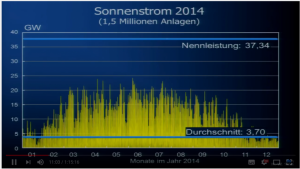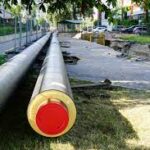Eerder kondigde ik de voordracht van de Duitse topeconoom, Hans-Werner Sinn, voormalig directeur van het IFO (te vergelijken met ons CPB), aan, getiteld: ‘Wieviel Zappelstrom verträgt das Netz?
Sinn begon zijn voordracht met Roland Berger, die op de eerste rij van de zaal zat, te feliciteren met diens 80ste verjaardag. Voor de kenners van het Duitse economische landschap was dit niet zo maar een felicitatie. Immers Roland Berger is een begrip in Duitsland. Hij bestiert een van de belangrijkste adviesbureau’s voor het bedrijfsleven in Duitsland en vele andere landen. Zijn prominente aanwezigheid aldaar mag dan ook zeker worden uitgelegd als instemming met het betoog van Hans-Werner Sinn. Dat geeft extra economische en politieke lading aan diens analyse.
Onder de titel, ‘Major Blow To ‘Energiewende’ As Top German Economist Shows Plan Can Never Work!, rapporteerde Pierre Gosselin daarover uitvoerig op zijn blog.
Germany’s once highly promoted “Energiewende” (transition to green energies) and the country’s feed-in act have been given a grade of “F” by one of the country’s top economists, Prof. Dr. Dr. h.c. mult. Hans-Werner Sinn.
Just days ago the renowned economics professor gave a presentation dubbed “How much volatile power can the power grid take?” before a packed audience in Munich:
Sinn says supplying Germany’s energy needs with wind and sun is “disillusionment”.
The basis of his presentation is a recent paper appearing in the European Economic Review: Buffering volatility, A study on the limits of Germany’s energy revolution.
In summary, Sinn claims it is unrealistic to believe that Germany can power itself with only wind and sun due to their immense supply volatility and that it is already a huge challenge in itself just to replace coal, oil and gas for producing electricity. Coal, oil and gas for electricity make up only a puny 12.8% of German total energy demand (chart 6:25-mark). He says:
As far as the rest, you can dream about it, but you cannot do it. […] It was disillusionment from the very start, and it’s important that this be made very clear.”
Sinn shows just how volatile wind and solar energies in Germany are, using 2014 as an example. At the time Germany had installed just over 24,000 turbines with a total rated capacity of almost 36 gigawatts:

However those turbines delivered on average only 5.85 gigawatts, well under 20%.
The numbers are even more gruesome for solar panel installations, which of course do not function at all at night.
Installed in Germany in 2014 were 37.34 gigawatts of rated solar capacity. Delivered however were merely a tenth of that amount, an average of 3.70 gigawatts. What it does, says Sinn:
It costs a horrendous sum of money, reduces standard of living and blights the landscape. This simply cannot be!”
 Sinn’s results are a major blow to the proponents of the German Energiewende and to the notion it is clean, cheap and reliable. As the numbers and results come in, it becoming increasingly clear that the German mega green project is turning into an embarrassing fiasco.
Sinn’s results are a major blow to the proponents of the German Energiewende and to the notion it is clean, cheap and reliable. As the numbers and results come in, it becoming increasingly clear that the German mega green project is turning into an embarrassing fiasco.
Sinn rhetorically asks whether it’s maybe possible to smooth the supply, i.e. using a variety of strategies such pump-storage and power-to-gas, in order to make the supply more steady, reliable and efficient. His answer is an emphatic no, saying: “It’s an Energiewende to nowhere.”
Even if Germany installed enough capacity to make its supply 100% green, 61% of the output would have to “scrapped” because there would be no use for it, Sinn shows, using a chart at the 55-min. mark.
The public, media and policymakers, however, refuse to acknowledge that the German man-on-the-moon energy project is in big trouble. At his blogsite, Holger Douglas commented on Sinn’s presentation and the failure of the Energiewende.
In the ensuing discussion one of the gravest consequences of the Energiewende emerged: the credibility of science. At almost every single research institute experts have been making every effort to dodge the fundamental laws of physics and nature in order to justify the Energiewende after the fact.”
Sinn also notes he believes the cost of the Energiewende will end up far exceeding the earlier government estimate of 1 trillion euros. Moreover he says that Germany is also transforming its idyllic landscape into a large industrial park.
The Energiewende is one green plan that is backfiring spectacularly on a scale few could have imagined earlier. And in typical German fashion, leaders refuse to acknowledge this and appear as if they would prefer to see the country descend (once again) into ruin before admitting they’ve erred.
Bron hier.
En dat alles met de zegen van Roland Berger dus.
Video hier.
Zou er nu niemand in Den Haag zijn die zich in het licht van deze grondige analyse een gevoel van twijfel in zich voelt opkomen over de vraag of we met het Nederlandse energie- cum klimaatbeleid op de goede weg zijn?
Hans-Werner Sinn is vergelijkbaar met ‘onze’ Laura van Geest, directeur van het CPB. Zij heeft de reputatie af en toe adviezen uit te brengen die politiek gevoelig liggen. Heeft zij nooit de behoefte gevoeld om de regering te adviseren zoals Sinn dat heeft gedaan? Zo niet, waarvoor hebben we dan toch zulke dure en hoog-gekwalificeerde ‘onafhankelijke’ adviesorganen?






Als dit interessante verhaal nu alleen bekend wordt in een zaal in Duitsland, bij Pierre Gosselin en hier op Climategate.nl, dan begrijp ik dat het allemaal weinig zin heeft. Hopelijk komt het ook op TV en de kranten, maar ….
Het SER+energie-akkoord en RutteIII’s extra “klimaat”-ambities worden zwaar politiek verdedigd met behulp van de “duurzame” wetenschap geheel toepassend GroenLinkse klimaatdogma’s. RutteIII is een rechts kabinet met een groenlinkse agenda en doelstellingen overgoten met gesubsidieerd VVD-“klimaat”-ondernemersschap en gesubsidieerde bandwaggon. We kunnen van het CBS, CPB, PBL, ECN, Universiteiten en andere 100% gesubsidieerde politiek afhankelijke instellingen geen kritiek daarop meer verwachten. Zou alleen de Algemene Rekenkamer nog onafhankelijk van de politiek zijn? Waar is de kritische journaille en de kritische wetenschap, ondergedoken in angst voor politieke represailles en ontslag?
Zou het misschien zo hebben kunnen zijn geweest dat : het allemaal van tevoren zo was bedacht ; dat Hans Werner Sinn en Roland Berger nu de vermoorde onschuld spelen en ineens kunnen uitrekenen dat 100 – 80 % ongeveer 20 % is en dat het CBS gewoon onderdeel was / is van de gehele opzet , net zoals in nederland het geval is ?
Het wordt tijd dat meer psychologen en psychiaters afstuderen en ingezet worden om onze leiders te onderzoeken. Ze kunnen bovenstaande toch ook lezen en conclusies trekken?
Of is het soms niet waar wat hier staat en weten ze ook waarom niet. Maar dan moeten ze dat duidelijker communiceren.
Het is duidelijk dat fossiel op de langere termijn geen houdbaar idee is. Maar er is voorlopig nog genoeg en dus geen haast. Zoals gezegd kunnen wind en zon onze grote energie behoefte niet dekken. Alleen thorium blijft over. Dus stop met al die subsidies naar wind, zon en andere twijfelachtige bronnen en doe goed onderzoek naar thorium als energiebron. Wellicht kunnen op zeer korte termijn al proefcentrales draaien en energie leveren.
Van mij mag dit best wat kosten, omdat we het nu over een adequate, praktisch oneindige bron hebben. Bovendien ook nog een bron waardoor niet het hele nederlandse landschap een industrieel karakter zal krijgen.
In Nl en Europa hebben we een infrastructuur voor onze energie voorziening die gebaseerd is op grootschalige opwekking….grote centrales zijn hierdoor en hiervoor onontbeerlijk om de netfrequentie op peil en dus stabiel te houden…dit gaat met Windmolens, Geothermie en Zonnepanelen simpelweg niet lukken vandaag niet morgen niet…WGZ zou hooguit lokaal kunnen werken zolang er voldoende wind en zon is maar ook dan zal er nog steeds back-up nodig zijn vanuit grootschalige opwekking…Thorium electriciteitscentrales zouden hierin een wezenlijke rol kunnen en vermoedelijk ook wel moeten gaan spelen…helaas heeft kernenergie obv Uranium 70 jaar geleden (tijdens de 2e wereldoorlog) de voorkeur gekregen omdat van het afval kernwapens gemaakt konden worden…we weten allemaal waarom en welke verschrikkelijke wreedheden hiermee zijn begaan in oa Japan…indien 70 jaar geleden de keuze was gemaakt voor Thorium energie was de milieu vervuiling en hierdoor klimaatverandering zeer waarschijnlijk significant minder geweest…Thorium lijkt mij daarom zeer zeker de moeite waard om verdere aandacht te krijgen…een belangrijke rol voor specialisten, techneuten en nucleaire reactor fysica zou hier kunnen zijn weggelegd…alleen een goed transparant en technisch verantwoord Nl en Europees beleid hiervoor kan ik helaas niet ontdekken…
Ik denk dat dit een kenmerkend geval is van: ‘je kunt niet eindeloos iedereen bedotten’. De samenloop van belangen van cultuurmarxistische groeperingen als de milieubeweging (voortbestaan = verdienmodel), de multinationals (verdienmodel) en de media (sensatie = verdienmodel). Vooral de rol van de media is kwalijk, omdat die hun kern-business verzaken door alle objectiviteit in de ban te doen, selectief te berichten en criticasters monddood te maken. Recentelijk was daar nog Joop met zijn smakeloze en naïeve publiciteitsstunt: https://www.lindanieuws.nl/nieuws/deze-ijsbeer-uitgemergeld-door-klimaatverandering-niet-helemaal-zo-blijkt/
Ik vraag mij dan af: waarom doet men dit? Is men daar bij Joop zich wel bewust van wat men mogelijk kan aanrichten? Ik vrees van niet. Nu zitten we vooral door toedoen van de media opgescheept met een ongekende geldverspilling aan de niet bestaand probleem die goeddeels in de zakken van multinationals verdwijnt en een deel in die van milieugroeperingen en de media. Allemaal geld dat beter besteed had kunnen worden aan het verder op weg helpen van Ontwikkelingslanden, malariabestrijding, boskap, uitbannen van indoor cooking etc. Het is duidelijk dat de MSM en cultuurmarxisten in dezen niet in het lot van Ontwikkelingslanden zijn geïnteresseerd, maar alleen in zichzelf. Een betoog van Sinn kan hier misschien verandering in brengen, maar zo lang de media hun verantwoordelijkheid uit de weg blijven gaan, vrees ik dat dit nog wel even zal duren. Uiteindelijk zullen natuurwetten het pleit hoe dan ook beslechten.
En laten we de reputatieschade van de wetenschap niet vergeten.
Je zou deze signalen naar elk kamerld moeten sturen, ik hoor bijna geen politicus in hun, deels slechts door ideologie ingegeven beargumentering, dat zij deze informatie meenemen in hun besluitvorming. Als ik het regeringsbesluit goed begrijp maakt me dat bloednerveus.
Het gaat om geld,mislukt geld,net als de langzaamlijn,er is aan verdiend,maar we hebben er niks aan,maar de rekening kwam.Ook nu vernietiging van landschap,maar niet zeuren,dat draaien we allemaal de nek om,lekker de banken geld laten maken,en Nederland het laten aflossen.Nederland is Rekeningland! of Berekeningland.
Eigenlijk wel heel veel woorden om uit te leggen dat aanbod gestuurde economie of handel of hoe je het noemen wilt gewoon ruk is.
En dan vraag je je af of Sinn het zelf wel begrijpt. Hij noemt kolenstroom ergens complementair aan “hernieuwbaar” terwijl het gewoon randvoorwaarde is.